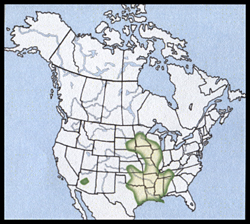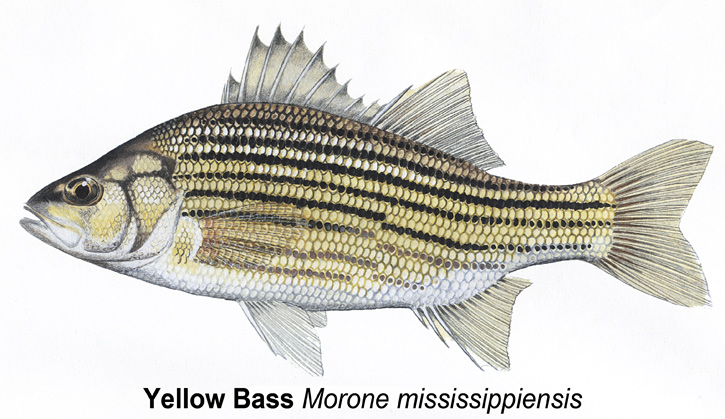Yellow Bass, February 2014, Fish of the Month!
A Brief Note to Our Readers:
The Yellow Bass is the third in our list of members of the Temperate Bass family.
Yellow Bass
Morone mississippiensis
Local Names:
Gold bass, Brassy bass, Bar fish, Striped jack
Average Size:
8 to 12 inches
1/2 to 3/4 pound
Distinguishing Field Marks:
(See the illustration.)
-
Distinctive yellow or golden color on the sides and head with dark lateral stripes.
-
The body, gill covers, and cheeks are scaled.
-
The upper and lower jaws are of equal length.
The 2 dorsal fins are joined, with usually 9 spines in the first, and 1 spine on the leading edge of the second.
-
The paired pelvic fins each have 1 spine.
-
The anal fin has 3 spines, the leading spine short and the following two longer and of nearly equal length.

The tail fin is moderately forked.
North American Range:
Map to the right shows approximate range in North America.
Diet:
Beginning with zooplankton, graduating to aquatic invertebrates, and then to a mix of invertebrates and fishes.
Biology:
In the same manner as the White bass, Yellow bass spawn in spring at water temperatures around 60 degrees F.. Spawning takes place as schools swim in shallow water, often in tributary streams, randomly releasing eggs and milt. The parents leave the spawning sites immediately after the eggs are spent and fertilized and return to deeper water. The eggs are adhesive and incubate for a short period while attached to whatever solid masses with which they have come into contact.
Fly Fishing for Yellow Bass:
As this species tends to move into deep water as temperatures rise, the best fishing will be in spring, right after the fish have finished their spawning. Yellow bass will take a variety of flies, but small streamers (both attractors and imitators) are likely to produce your best results. These pretty fish will take your offering better when it is presented with a slow retrieve.
Five and six weight fly outfits will cover all your Yellow bass fly fishing needs.
Because they move in schools, staying with Yellow bass (as is the case with all the Temperate bass species) is best accomplished when fishing from a boat or canoe.
Yellow bass are short-lived and run in erratic cycles of very good or very poor years. Since they are an excellent food fish, it is recommended that they be taken for this purpose when their numbers are high.
Significance to Humans:
Taken in large numbers by anglers within their range for direct consumption, they may occasionally be found in local markets.
Status:
Maintaining or thriving, dependent on habitat and local conditions.







